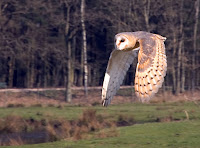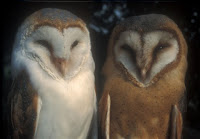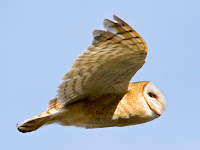BARN OWL
BARN OWL (Tyto alba) – (See images below)
DESCRIPTION: The Barn Own has a large heart-shaped white facial disk edged in light reddish-brown. Face is rather flat. Upper parts are generally reddish beige with grey patches. Under parts are white, sometimes with dark specks. Wings are long, rounded and barred with brown. Tail is short. Neck is short and not visible in flight. Eyes are black, sometimes with a faint beige smudge around them. Bill is short and hooked, and light grey. Legs are long and mostly covered with white feathers. Feet are dark grey, talons are black. Females are around 10% larger than males. Bird length is around 35 cm (14 inches). There are more than 30 subspecies.
VOICE: https://www.xeno-canto.org/species/Tyto-alba – this owl does not hoot, but ‘shrieks’ rather.
NAME: ‘Barn’ in the name refers to a favorite nesting site of this owl; ‘Owl’ is an onomatopoeia for the bird’s call (although it does not hoot). Also called ‘Common’ Barn Owl to distinguish it from other species in same family. Latin genus name ‘Tyto’ means ‘owl’, and Latin species name ‘alba’ means ‘white’.
HABITAT: Grasslands, especially tall ones.
DIET: Small mammals, birds, reptiles, insects. Hunts at night (mostly) by hovering low and searching for prey mainly by sound.
NESTING: Nest located in a cavity, either natural (tree or rock crevice) or in a barn or other man-made structure. No nest per se is built, rather eggs are surrounded by regurgitated pellets. Around five white eggs are laid, incubated by the female. Chicks fed by the female, while male brings her food.
DISTRIBUTION: Covers every continent except Antarctica. Usually a year-round resident. Absent in most of Canada except southern British Columbia and southern Ontario. Absent in African Sahara. Absent in most of Asia (except southeast Asia) and Scandinavia. Mostly absent in New Zealand.
Distribution Map: https://en.wikipedia.org/wiki/Barn_owl#/media/File:Schleiereule-Tyto_alba-World.png
ON HAWAII: Introduced on Hawaii in the 1960s for rodent control, now established and common on all main islands.
ON PEI: Does not breed on Prince Edward Island neither in the Maritimes. Sightings on the island have been ‘accidental’ (vagrant birds) in fall and winter. (see note below on Bird Vagrancy).
CONSERVATION: Widespread and common, not at risk globally, but in Canada the species has disappeared from most of its southern range, notably in Ontario. It is listed as endangered in Canada. Causes include habitat loss due to different farming practices, loss of nesting sites due to modern farm buildings, use of rodenticides which poison their main prey, and vulnerability to extreme colds. Barn owls are also vulnerable to road kills because of their hunting habits, flying low over fields. There are programs in place in Canada to try and restore this owl’s habitat, such as this one on the British Columbia south west coast. Here’s a website for providing nest boxes.
Vagrancy: In biology this means an animal going way outside its normal range. For birds, this can happen when there are storms and they get blown off course. On other times, the bird simply wanders in a different direction than usual. Here’s an article about vagrancy in birds.
REFERENCES: https://en.wikipedia.org/wiki/Barn_owl
https://nature.mdc.mo.gov/discover-nature/field-guide/barn-owl (Missouri Department of Conservation)
https://guides.nynhp.org/barn-owl/ (New York Natural Heritage Program)
https://animaldiversity.org/accounts/Tyto_alba/ (University of Michigan Zoology)
http://nzbirdsonline.org.nz/species/barn-owl (New Zealand Birds Online)
https://txtbba.tamu.edu/species-accounts/barn-owl/ (Texas Breeding Bird Atlas)
https://www.birdscanada.org/research/speciesatrisk/bnow/
https://www.ontario.ca/page/barn-owl (Species At Risk)
https://www.canada.ca/en/environment-climate-change/services/species-risk-public-registry/recovery-strategies/barn-owl-eastern-population-2016.html
http://www.natureconservancy.ca/en/what-we-do/resource-centre/featured-species/birds/barn_owl.html
https://www.allaboutbirds.org/guide/Barn_Owl/id
https://www.audubon.org/field-guide/bird/barn-owl
https://www.barnowltrust.org.uk/barn-owl-facts/ (Conservation)
https://www.owlpages.com/owls/species.php?s=10
https://www.thespruce.com/barn-owl-387223
DESCRIPTION: The Barn Own has a large heart-shaped white facial disk edged in light reddish-brown. Face is rather flat. Upper parts are generally reddish beige with grey patches. Under parts are white, sometimes with dark specks. Wings are long, rounded and barred with brown. Tail is short. Neck is short and not visible in flight. Eyes are black, sometimes with a faint beige smudge around them. Bill is short and hooked, and light grey. Legs are long and mostly covered with white feathers. Feet are dark grey, talons are black. Females are around 10% larger than males. Bird length is around 35 cm (14 inches). There are more than 30 subspecies.
VOICE: https://www.xeno-canto.org/species/Tyto-alba – this owl does not hoot, but ‘shrieks’ rather.
NAME: ‘Barn’ in the name refers to a favorite nesting site of this owl; ‘Owl’ is an onomatopoeia for the bird’s call (although it does not hoot). Also called ‘Common’ Barn Owl to distinguish it from other species in same family. Latin genus name ‘Tyto’ means ‘owl’, and Latin species name ‘alba’ means ‘white’.
HABITAT: Grasslands, especially tall ones.
DIET: Small mammals, birds, reptiles, insects. Hunts at night (mostly) by hovering low and searching for prey mainly by sound.
NESTING: Nest located in a cavity, either natural (tree or rock crevice) or in a barn or other man-made structure. No nest per se is built, rather eggs are surrounded by regurgitated pellets. Around five white eggs are laid, incubated by the female. Chicks fed by the female, while male brings her food.
DISTRIBUTION: Covers every continent except Antarctica. Usually a year-round resident. Absent in most of Canada except southern British Columbia and southern Ontario. Absent in African Sahara. Absent in most of Asia (except southeast Asia) and Scandinavia. Mostly absent in New Zealand.
Distribution Map: https://en.wikipedia.org/wiki/Barn_owl#/media/File:Schleiereule-Tyto_alba-World.png
ON HAWAII: Introduced on Hawaii in the 1960s for rodent control, now established and common on all main islands.
ON PEI: Does not breed on Prince Edward Island neither in the Maritimes. Sightings on the island have been ‘accidental’ (vagrant birds) in fall and winter. (see note below on Bird Vagrancy).
CONSERVATION: Widespread and common, not at risk globally, but in Canada the species has disappeared from most of its southern range, notably in Ontario. It is listed as endangered in Canada. Causes include habitat loss due to different farming practices, loss of nesting sites due to modern farm buildings, use of rodenticides which poison their main prey, and vulnerability to extreme colds. Barn owls are also vulnerable to road kills because of their hunting habits, flying low over fields. There are programs in place in Canada to try and restore this owl’s habitat, such as this one on the British Columbia south west coast. Here’s a website for providing nest boxes.
Vagrancy: In biology this means an animal going way outside its normal range. For birds, this can happen when there are storms and they get blown off course. On other times, the bird simply wanders in a different direction than usual. Here’s an article about vagrancy in birds.
REFERENCES: https://en.wikipedia.org/wiki/Barn_owl
https://nature.mdc.mo.gov/discover-nature/field-guide/barn-owl (Missouri Department of Conservation)
https://guides.nynhp.org/barn-owl/ (New York Natural Heritage Program)
https://animaldiversity.org/accounts/Tyto_alba/ (University of Michigan Zoology)
http://nzbirdsonline.org.nz/species/barn-owl (New Zealand Birds Online)
https://txtbba.tamu.edu/species-accounts/barn-owl/ (Texas Breeding Bird Atlas)
https://www.birdscanada.org/research/speciesatrisk/bnow/
https://www.ontario.ca/page/barn-owl (Species At Risk)
https://www.canada.ca/en/environment-climate-change/services/species-risk-public-registry/recovery-strategies/barn-owl-eastern-population-2016.html
http://www.natureconservancy.ca/en/what-we-do/resource-centre/featured-species/birds/barn_owl.html
https://www.allaboutbirds.org/guide/Barn_Owl/id
https://www.audubon.org/field-guide/bird/barn-owl
https://www.barnowltrust.org.uk/barn-owl-facts/ (Conservation)
https://www.owlpages.com/owls/species.php?s=10
https://www.thespruce.com/barn-owl-387223
 |
| Barn Owl – Brazil – Dario Sanches |
 |
| Barn Owl – British Wildlife Centre Surrey, UK– photo by Peter Trimming |
 |
| Barn Owl in flight – Sandesneben, Germany –photo by Jürgen |
 |
| Barn Owl owlets shedding their down Rainbow, CA –photo by chdwckvnstrsslhm |
 |
| Barn Owls, different subspecies Netherlands – photo by HeBi |
 |
| Barn Own in flight – Carrizo Plain National Monument, CA Bill Bouton |